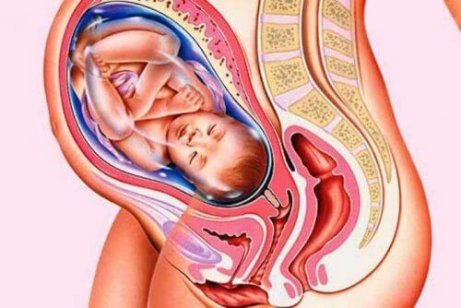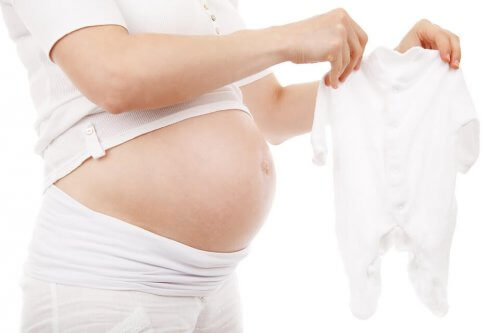8 Early Labor Signs You Need to Know

Early labor signs are the symptoms that indicate that the time to give birth to your child is approaching. It’s normal for a woman’s body to prepare itself and show that the baby’s arrival is not far off.
However, not all women present the same symptoms with the same intensity. In fact, in some cases, women can miss the signs or misinterpret them.
This phase doesn’t begin at a pre-determined moment or last a specific amount of time. Actually, each woman will experience these early labor signs differently. In the same way, early labor can last several hours, or it can last up to one or two weeks.
Early labor signs
Predicting the exact moment that early labor begins is impossible. Just the same, it’s important to understand the changes that occur in order to avoid confusion and reduce anxiety:
1. Increased frequency of Braxton Hicks contractions
These contractions, also known as practice contractions, become more evident and appear repeatedly as your child‘s arrival approaches.
The contractions will be irregular during early labor. They appear because the uterine wall begins to prepare for dilation.
Braxton Hicks contractions can appear as often as every 10 or 20 minutes. For that reason, mothers often mistake them for labor contractions.
However, they don’t become more intense, and they disappear after a bit of rest. This is how you can determine that the contractions are part of early labor and not labor itself.

2. The baby descends and becomes square with the pelvis
The baby begins to drop in preparation for birth. As a result, your baby moves less, because he or she has less room to wiggle.
Pregnant women will feel more pressure and weight on the pelvic and rectal zones. Furthermore, the mother will have the sensation that breathing has become more difficult.
Normally, babies drop around weeks 37 or 38. However, when a woman has already given birth to older siblings, the baby may drop at a later date.
3. Changes to the uterine wall
During early labor, the cervix – or the uterine wall – becomes more flexible and starts to dilate. When your baby’s due date arrives, your doctor will check to see how much you’ve dilated and how far you have to go.
4. The need to urinate frequently
This occurs because the uterus puts pressure on the bladder, leaving the bladder with less room. Though this issue may appear earlier in pregnancy, it becomes more intense during early labor.
5. Losing the mucus plug
The mucus plug is a thick liquid that blocks the cervical canal and protects the uterus from bacteria and pathogens. When the cervix dilates, the mucus plug is released.
This may happen all at once, or over the course of a few days. Some women don’t even notice. Others notice the gel-like discharge, which may also have a bit of blood in it.
6. Getting everything prepared
As a baby’s due date approaches, pregnant mothers develop an innate need to start getting everything ready for the arrival. This instinct is called “nesting.”
The need to get everything in order increases during early labor, and has to do with a biological pattern that appears in other species as well.
7. Irritability
Although this doesn’t always occur, women in early labor often become more sensitive or irritable in certain situations. This has to do with multiple hormonal changes that occur during pregnancy, especially in the final stage.

8. Water breaking
When a woman’s water breaks, this is a sign that labor is imminent. This refers to the moment in which the sac of amniotic liquid that protects and covers the baby breaks.
When this occurs, the whitish liquid exits the woman’s body through the vagina. Water breaking is different than any other process because it’s impossible for the woman to hold it in.
If contractions don’t appear within several hours of your water breaking, you should head to the hospital. Your doctor will likely induce labor, as your baby cannot go very long without amniotic liquid.
As you can see, nature takes over and prepares the woman’s body for childbirth and the arrival of a new baby. However, every woman experiences early labor in a unique way.
Even so, it’s best to know these eight early labor signs so that you can recognize them as they come. This will allow you to face the final stage of your pregnancy in a more relaxed way.
Early labor signs are the symptoms that indicate that the time to give birth to your child is approaching. It’s normal for a woman’s body to prepare itself and show that the baby’s arrival is not far off.
However, not all women present the same symptoms with the same intensity. In fact, in some cases, women can miss the signs or misinterpret them.
This phase doesn’t begin at a pre-determined moment or last a specific amount of time. Actually, each woman will experience these early labor signs differently. In the same way, early labor can last several hours, or it can last up to one or two weeks.
Early labor signs
Predicting the exact moment that early labor begins is impossible. Just the same, it’s important to understand the changes that occur in order to avoid confusion and reduce anxiety:
1. Increased frequency of Braxton Hicks contractions
These contractions, also known as practice contractions, become more evident and appear repeatedly as your child‘s arrival approaches.
The contractions will be irregular during early labor. They appear because the uterine wall begins to prepare for dilation.
Braxton Hicks contractions can appear as often as every 10 or 20 minutes. For that reason, mothers often mistake them for labor contractions.
However, they don’t become more intense, and they disappear after a bit of rest. This is how you can determine that the contractions are part of early labor and not labor itself.

2. The baby descends and becomes square with the pelvis
The baby begins to drop in preparation for birth. As a result, your baby moves less, because he or she has less room to wiggle.
Pregnant women will feel more pressure and weight on the pelvic and rectal zones. Furthermore, the mother will have the sensation that breathing has become more difficult.
Normally, babies drop around weeks 37 or 38. However, when a woman has already given birth to older siblings, the baby may drop at a later date.
3. Changes to the uterine wall
During early labor, the cervix – or the uterine wall – becomes more flexible and starts to dilate. When your baby’s due date arrives, your doctor will check to see how much you’ve dilated and how far you have to go.
4. The need to urinate frequently
This occurs because the uterus puts pressure on the bladder, leaving the bladder with less room. Though this issue may appear earlier in pregnancy, it becomes more intense during early labor.
5. Losing the mucus plug
The mucus plug is a thick liquid that blocks the cervical canal and protects the uterus from bacteria and pathogens. When the cervix dilates, the mucus plug is released.
This may happen all at once, or over the course of a few days. Some women don’t even notice. Others notice the gel-like discharge, which may also have a bit of blood in it.
6. Getting everything prepared
As a baby’s due date approaches, pregnant mothers develop an innate need to start getting everything ready for the arrival. This instinct is called “nesting.”
The need to get everything in order increases during early labor, and has to do with a biological pattern that appears in other species as well.
7. Irritability
Although this doesn’t always occur, women in early labor often become more sensitive or irritable in certain situations. This has to do with multiple hormonal changes that occur during pregnancy, especially in the final stage.

8. Water breaking
When a woman’s water breaks, this is a sign that labor is imminent. This refers to the moment in which the sac of amniotic liquid that protects and covers the baby breaks.
When this occurs, the whitish liquid exits the woman’s body through the vagina. Water breaking is different than any other process because it’s impossible for the woman to hold it in.
If contractions don’t appear within several hours of your water breaking, you should head to the hospital. Your doctor will likely induce labor, as your baby cannot go very long without amniotic liquid.
As you can see, nature takes over and prepares the woman’s body for childbirth and the arrival of a new baby. However, every woman experiences early labor in a unique way.
Even so, it’s best to know these eight early labor signs so that you can recognize them as they come. This will allow you to face the final stage of your pregnancy in a more relaxed way.
This text is provided for informational purposes only and does not replace consultation with a professional. If in doubt, consult your specialist.








